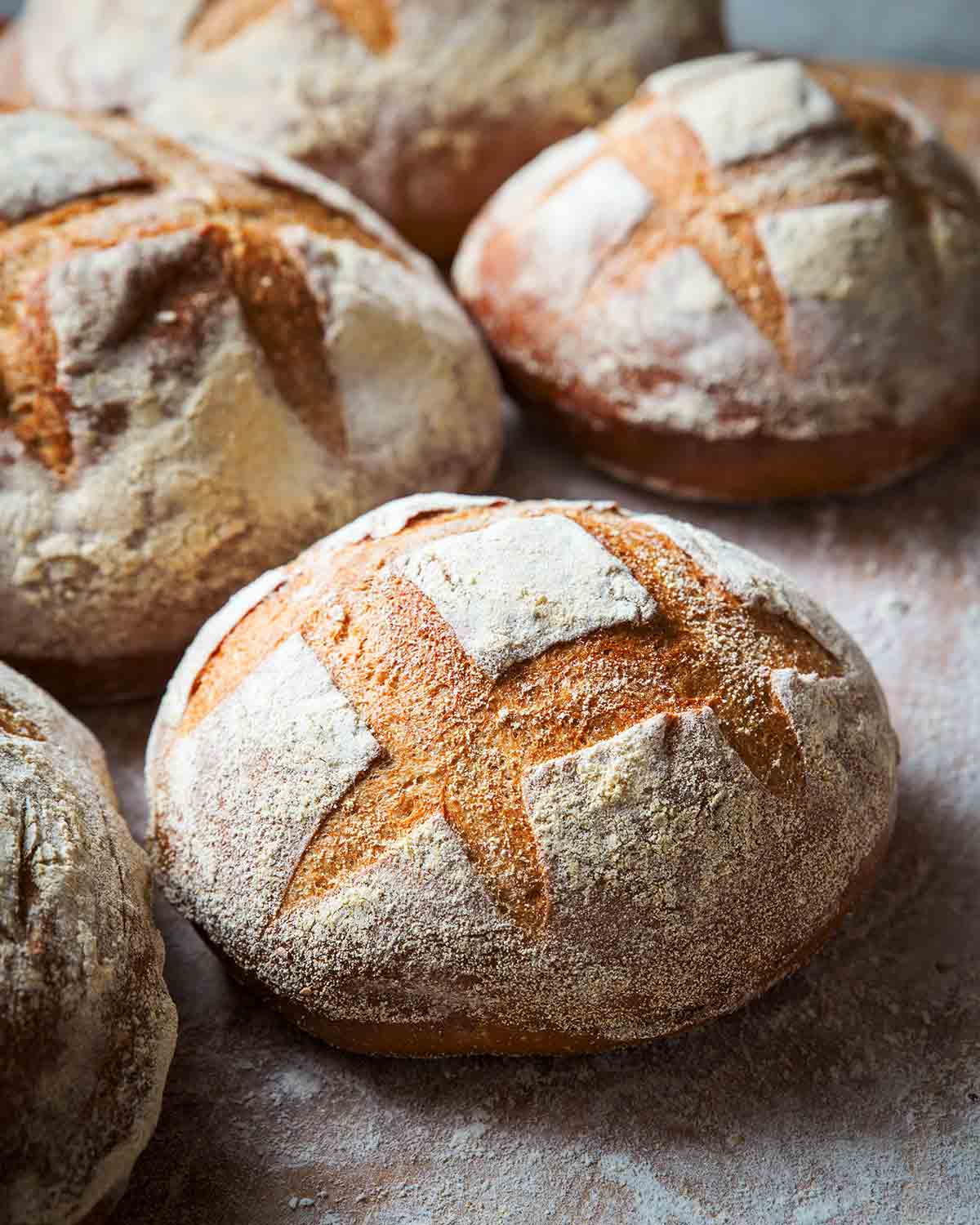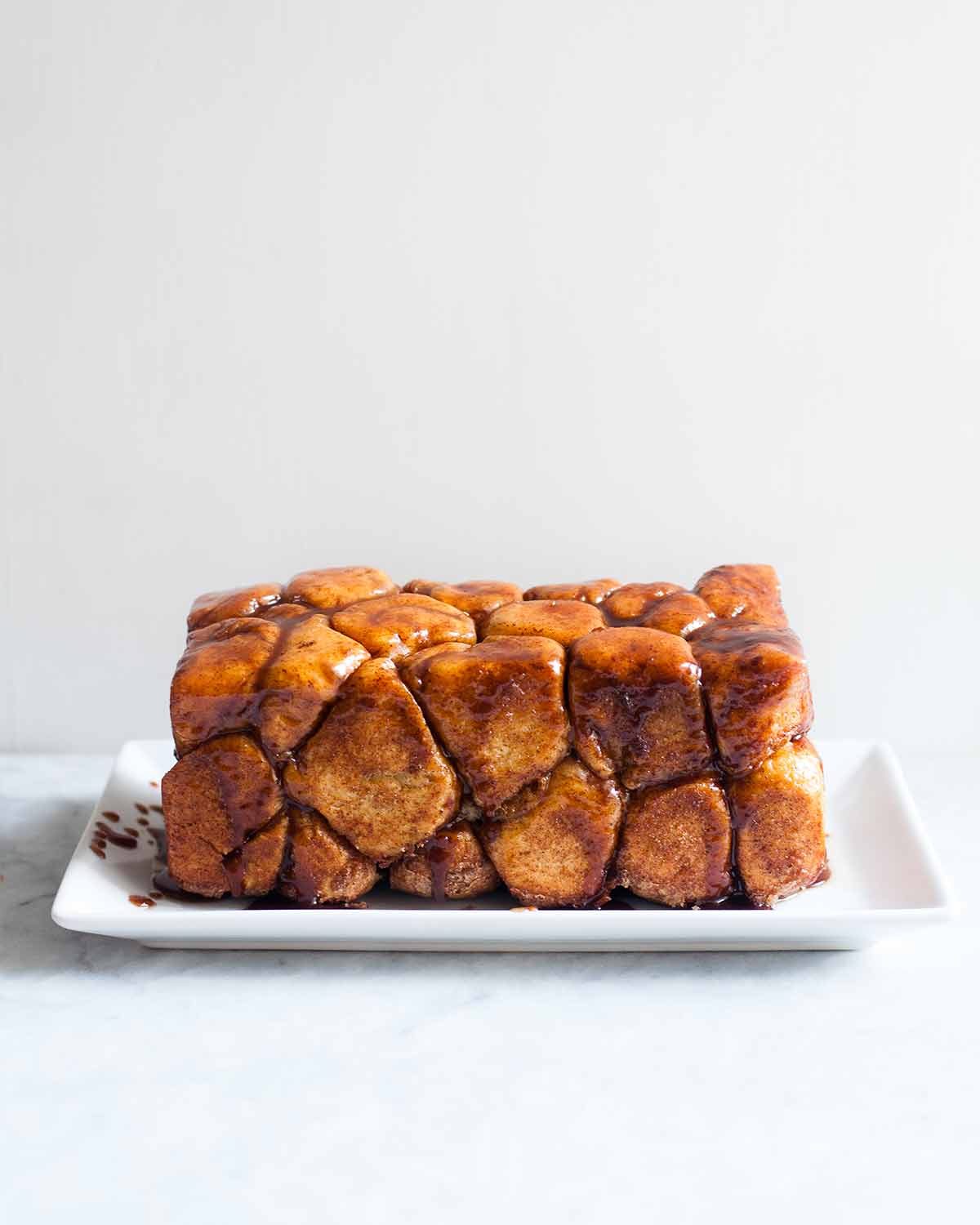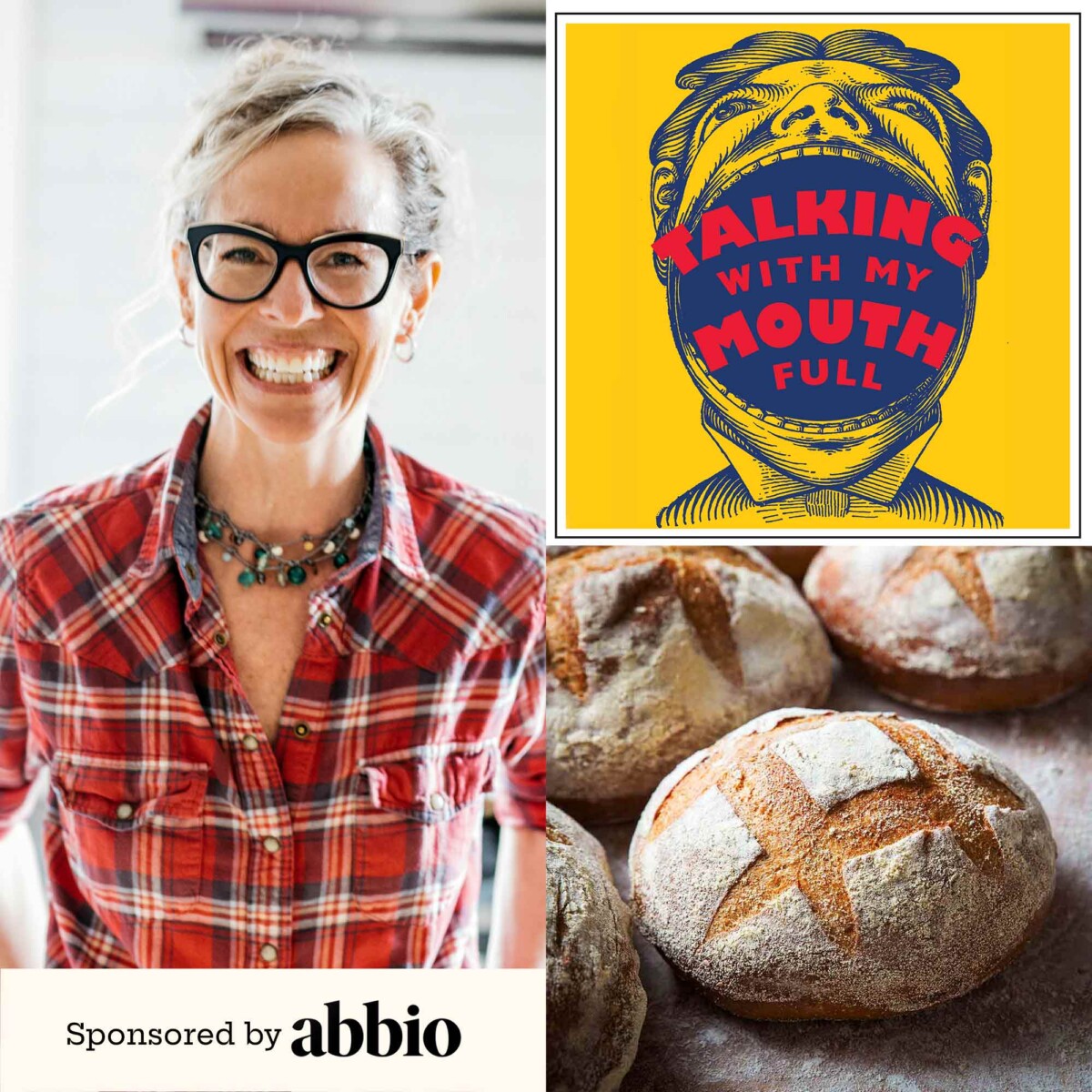
Follow on Apple | Spotify | Stitcher | Amazon | Google | iHeart | TuneIn
Contents
☞ If you like what you hear and would like to support us, even $1 will help! Thank you.
Chat with us

Have a cooking question, query, or quagmire you’d like Amy and David to answer? Click that big-mouth button to the right to leave us a recorded message. Just enter your name and email address, press record, and talk away. We’ll definitely get back to you. And who knows? Maybe you’ll be featured on the podcast!
Introduction
We can think of no better way to take comfort as the days pass than baking no-knead bread while quarantined. (Well, we should probably say we can think of very few better ways…) And so, with no more ado, we want to introduce you to the simplest, most reliable homemade bread recipe on our site. It’s long been a go-to recipe for you, dear readers, whether you’re an experienced bread baker or haven’t baked since your Easy-Bake Oven days.
The recipe’s draw is that it requires much less handling and fuss than any other bread dough we’ve ever made. And the dough can be kept in the fridge for you to simply reach for and, in literally 5 minutes, shape a loaf whenever the craving reveals itself. Not surprisingly, it’s popularity has risen exponentially in recent weeks when more folks have time to fiddle in the kitchen. The irony, though, is that it actually requires no fiddling.
The recipe is the brainchild of baker extraordinaire Zoe François and her co-author, Jeff Hertzberg. So we invited her to divulge a little about how the recipe came to be and to share some additional insights she’s discovered in the years since she first concocted this brilliance. You’re going to want to listen to this.

Podcast transcript
David Leite: Renee, with everyone stocking up so they can hunker down in place for who knows how long, do you know the two things I was never able to buy?
Renee Schettler: No, what?
David Leite: Distilled water for my CPAP. So apparently, everyone in the world has sleep apnea, besides me–
Renee Schettler: Or maybe they’re just at home ironing a lot. Nervous energy.
David Leite: Oh yeah, that’s true. You need distilled water for ironing. And the other thing is–get this–flour. All the stores we went to, four or five in New York and also in Connecticut, completely sold out of flour.
Renee Schettler: And that makes perfect sense to me. Flour’s sold out here as well. Everybody I know is baking bread. It’s just, it’s calming. There’s that amazing quote from M. F. K. Fisher. She says, “No yoga exercise, no meditation in a chapel filled with music will get rid of your blues better than the humble task of making your own bread.”
David Leite: Yeah. Well, I know a little something about crazy bread making, don’t I?
Renee Schettler: Well, we know about bread baking, you know about crazy.
David Leite: Hello, I’m David Leite, founder of the website Leite’s Culinaria.
Renee Schettler: And I’m Renee Schettler, editor in chief.
David Leite: And this is Talking With My Mouth Full. On today’s episode, we’re all bread, all the time.
Renee Schettler: And who better to shoot the dough with us than Zoë François? She’s co-author of seven books on baking bread, including the seminal Artisan Bread in Five Minutes a Day. I like to think of her as sort of the Buddha of bread baking.
David Leite: Zoë, welcome.
Zoë François: Hi, thank you. I love that description. It’s perfect.

David Leite: Zoë, I have to tell you, the bread section of Leite’s Culinaria has exploded. People are making bread like crazy, as we all hunker down now, and the number-one most-popular recipe is your five-minute artisan bread. I mean, hundreds and hundreds more people are making it now.
Zoë François: Yeah, yeah. We’re finding it on our website as well. I mean, I think like Renee said, it’s so comforting. It’s that, but it’s also such a useful skill to have, especially in these times when people are actually in their houses feeding themselves. I think they’re learning new skills, and what better skill to have then to be able to bake bread for yourself and your family?
Renee Schettler: Absolutely.
David Leite: So for those, I don’t know, six people left on the planet who don’t know what’s five-minute artisan bread is, can you explain what that is?
Zoë François: Yeah, yeah. So my co-author Jeff Hertzberg, is a physician and when he was a resident in school, he decided to take up the hobby of baking bread. And so, his wife, Laura, taught him how to bake bread, and being Jeff, I know this doesn’t sound like it goes with the personality of a doctor, but he’s a little bit lazy. And so, he just kept dropping off parts of the process, and–
Renee Schettler: Oh my God.
David Leite: Uh-huh (affirmative)
Zoë François: Yeah, it’s hilarious. But he was working like a hundred hours a week as a doctor in a hospital, and baking bread, and so, I think what happened is he just started storing the dough, because he would have a shift and he wouldn’t be able to get to it, and then it got longer, and longer, and longer. And so, the premise of our bread is that you mix up a big batch. About enough for four one-pound loaves or even more, in some cases. You’re just dumping all the ingredients into a large container, stirring it up. It’s a no-knead bread, so you’re just stirring just until everything is incorporated, you let that rise so that the yeast can do its business, cover it up. In some cases, you can use it right away. In other cases, you need to refrigerate it to firm it up a little bit, and then you can store that dough from anywhere from five days to two weeks, depending on the dough that you’re making.
So with the dough that you’re talking about, that’s on your website, it’s four ingredients: water, salt, yeast, and flour, and that’s it. You put that in the bucket, you stir it up, and that dough can be stored for up to two weeks, and that’s the whole thing with our bread, so that when you want to bake a loaf of bread, you just pull a piece out, let it rest, and bake it, and you have dough on the ready.
Renee Schettler: I love that. I think the hardest part about the whole recipe, is just right now, finding the yeast and finding the flour.
Zoë François: Yeah, absolutely.
David Leite: Yes, exactly. And so, we have lots and lots of questions from our readers that they’ve asked us. Can we ask some of you?
Zoë François: Sure. Yeah.
David Leite: I think the one that relates to what Renee just said, some people are saying because flour is so scarce and so is yeast, can they make half a batch?
Zoë François: Absolutely. You can–
Renee Schettler: Nice.
Zoë François: The first book that we wrote, Artisan Bread in Five Minutes a Day, we did it only in cup measures, because it was a long time ago, and the scale–
David Leite: Back in the day.
Zoë François: Back in the day, when scales were exclusively used in Europe; they were way ahead of us. But Americans are now baking with weights, which is amazing. It’s just, every time you bake a loaf, it’s more consistent, but it also makes scaling a recipe much, much easier. So our new edition of that book has weights, and so if you have that book, you just cut the recipe in half. Again, it’s easier if you’re doing it by weight, but you can do it by the cups as well, and it absolutely works. You don’t have the same time savings because the whole premise is that you’re making a big batch of dough, and so you’re doing all the work once for all of the other loads. So it’s not quite as much time savings, but absolutely can be done.
David Leite: So would the dough rest on the counter for the same amount of time for a half recipe?
Zoë François: Absolutely, because the yeast, despite how much dough you’re making, the yeast still has to do its thing. So having said that, if you’re using warm water in your recipe, the yeast will activate sooner or faster. If you’re using cold water, it takes the yeast longer to rise. And so, both of those things are fine. Some people actually like the flavor of a dough that rises or ferments slowly, and so using cold water is their go-to. But yes, you still need to let the dough rise for the full amount of time.
Renee Schettler: Zoë, what if you did make the full batch of dough, but wanted to freeze part of it? Could you do that, or would that retard the yeast?
Zoë François: Absolutely. Yeah, it does retard the yeast, but that’s kind of what you’re going for. So if you want–
Renee Schettler: True.
Zoë François: … and the other thing is that it also stops the fermentation.
Renee Schettler: Nice.
Zoë François: So some people like the flavor of the dough after one to maybe three days fermentation, and then they’ll freeze it. I usually freeze it in like one pound packets so that it’s manageable when you’re taking it out of the freezer, but it’s a great way to sort of lock in that flavor profile that you like. When I first met Jeff, he was storing his dough for 30 days.
David Leite: Oh my.
Zoë François: And–
Renee Schettler: Yeah, whoa.
Zoë François: And then we decided to create a book out of this, I was like, there is no way I’m putting my name on a book telling people they’re going to store this dough for 30 days, just because it’s a pretty funky dough.
Renee Schettler: Yeah.
Zoë François: You can do it, absolutely, and Jeff still does, and it’s totally fine in terms of safety, but it is very sour and very funky. So I like my dough more in the first week, and he likes his really extreme.
David Leite: A month later.
Zoë François: So you be you, decide what you like in terms of flavor, but yeah, freezing, it’s a great option. Mm-hmm.
Renee Schettler: Into the freezer it goes. How would I defrost it? Would I do that at room temperature or in the fridge?
Zoë François: Well, I typically, if you are planning ahead, I would take it out of the freezer, put it in the refrigerator, and then treat it as if it’s coming straight out of the original container, so that it has defrosted in the refrigerator, will still be cold, and so you have to let it… Then you shape it and then let it rest on the counter.
Renee Schettler: Sure.
Zoë François: If you have not planned ahead, you can let it rest on the counter, and all of that will happen a little bit faster. But yeah, either way, it works. Very forgiving. This whole process is super forgiving, which is exactly why we did it, because we knew people were intimidated by bread baking and working with yeast, and there’s really nothing scary about it. In fact, I think it’s great fun. So we tried to create a recipe that was going to be as accessible and fun, and lacking all of the sort of intimidation as possible.
Renee Schettler: I love that.
David Leite: Another question we get a lot is when do you add mix-ins? And another question is, what are your favorite mix-ins to add to the master recipe?
Zoë François: Yeah. Well, okay, you can either add the mix-ins, like raisins, and nuts, or olives, and cheese, or herbs, and whatever you happen to have in the pantry right now, put it in there. So you can either add them when you’re mixing the whole batch of dough, but then you have that flavor in all of your loaves. The other way you can do it is to mix up your batch of dough, do the whole process of rise and refrigerate, and then pull out your piece of dough, and you can add your mix-ins at that point.
And the way that I do it, is I just roll the dough out maybe to about a half an inch thick, doesn’t matter which shape, half an inch thick, put your flavorings, let’s just say raisins, on the dough, roll it up into a log, and then rolling it into a ball, and then knead it just a little bit. So a few turns with the palm of your hand, just kneading those ingredients into the dough. When you do that, you have to let that dough rest a little bit longer than the recipe says, because you’ve kneaded all of the air, that’s all those nice bubbles that you’ve created from letting it rise, out of the dough. So you need to let the dough rise a little bit longer, whenever you’re handling it that much.
Renee Schettler: And then once the bread is baked, how do you keep it?
Zoë François: It depends on the kind of bread, but typically if you’re doing a crusty boule, you never want to cover that, because if you were to put it into plastic, you’re going to destroy that nice crispy crust that you’ve developed.
Renee Schettler: Exactly.
Zoë François: So what I usually do, especially with a loaf that’s just flour, salt, yeast, and water, it’s not going to last that long. It’s best to have that baked fresh, and so maybe a day or two.
Renee Schettler: Okay.
David Leite: Mm-hmm (affirmative).
Zoë François: And what I do is I just lay the cut end down on a hard, flat surface, so marble or even wood is fine, to sort of make sure that that cut end is not going to be exposed to air so it won’t dry out. The other thing that you can do if you do want to cover it, is just put it into a paper bag, not plastic. Plastic will really just destroy any kind of crispy crust that you get.
David Leite: So what about those bags that you get that have actually holes in them, small holes?
Zoë François: Mm-hmm. Yeah.
David Leite: Do those work?
Zoë François: Yeah. I mean, the ones that you would get from a bakery or something.
David Leite: Yeah, or from King Arthur or something like that.
Zoë François: Yeah, yeah, yeah. If you can get a hold of them, there are some bags, the perforated bags like that, or cloth bags you can also find. So yeah, absolutely. If you have them, terrific. This is just, everybody has a paper bag laying around. So if you’re uncertain what was in that paper bag beforehand, I usually wrap the bread in a bit of parchment paper first, just so that-
David Leite: That’s smart. Yeah. No flavor transfer.
Zoë François: Right.
Renee Schettler: Right? Back to that funkiness topic.
Zoë François: Yes, exactly.
Renee Schettler: And so, Zoë, I always bake bread on a cast iron skillet turned upside down, because I’m too cheap to buy a baking stone.
Zoë François: Awesome.
David Leite: And I use a baking stone, I follow instructions, thank you very much.
Renee Schettler: And I don’t, and a lot of our readers don’t as well, thank you very much, because they don’t have either.
David Leite: Mm-hmm (affirmative).
Renee Schettler: So can they use a standard baking sheet or what would you recommend?
Zoë François: Yeah. Okay, so cast iron is great, because cast iron is thick enough to retain heat, and so the whole premise of having a baking stone on your bread is that one, it retains heat so that when you’re opening the oven, the heat isn’t just sort of rushing out of there, because you want a really nice hot oven to get any oven spring out of your dough. It retains the heat, and it also conducts heat really well. And so again, you’re giving that dough a really nice jolt of heat, which is going to give you a nice oven spring to your bread.
Zoë François: So cast iron, or a really well pre-heated ceramic, or a steel is going to be the best way to bake your bread. Just a regular old jelly roll pan or cookie sheet is so thin that it doesn’t really retain or conduct heat that well. So you can absolutely do it, it’s just if you get into this and you’re trying to get that really great crispy crust, I would say either do what you’re doing, is flipping a cast iron pan upside down, or they sell terracotta, unglazed terracotta tiles that are really inexpensive.
Renee Schettler: That’s brilliant.
Zoë François: Anything that’s sort of thick enough and will conduct heat, is the way to go.

David Leite: And I don’t know if a lot of our new readers and also listeners know this, but also with this same bread, you can make a phenomenal brioche, and Zoë was kind enough to come over to Connecticut with The One and me to be able to make the cinnamon rolls, and you can make cinnamon rolls with it, you can make monkey bread. Both of those recipes are on the site, and there are so many other things that you can make with artisan bread in five minutes a day. So realize that guys, it’s beyond just a regular plain boule.

Zoë François: Yeah, with our recipes, I mean in our books, each one of them has about a hundred recipes. So it’s just as easy as what I described before, where you dump everything into a bucket and stir it up. It’s just a different list of ingredients. So like the recipe that you and I made together, which was so much fun by the way, we have to do that again.
David Leite: Yes, we do.
Zoë François: We added butter, and eggs, and a bit of honey for some sweetness, but exactly the same way. We just dumped it in and stirred it up. It’s nothing more difficult than any of the others. So all the same method, just different lists of ingredients to get a different type, that would be called an enriched dough. So that kind of dough would only last in the refrigerator for up to five days, because it has the eggs and the butter in it, and after that, just like Renee said, you would want to freeze any leftover dough, because with eggs, you just don’t want to play around with that, so we just freeze it, and that dough will last for about three weeks, four weeks in the freezer.
David Leite: Well, Zoë, we want to thank you so much for coming on, answering our readers’ questions, in this special time of intense enhanced bread baking. Thank you so much.
Renee Schettler: Thanks, Zoë.
Zoë François: Yeah. Oh, it was absolutely my pleasure, and happy baking.
Renee Schettler: Zoë François, along with her writing partner, Jeff Hertzberg, is an unequivocal bread maestro. She’s written seven Artisan Bread in Five-Minutes a Day cookbooks, and you can find Zoë online at zoebakes.com, as well as on her stunning Instagram feed. Her handles are @zoebakes, and @breadin5, and that’s the numeral five.
David Leite: This podcast is produced by Overit Studios, and our producer is the indefatigable Adam Clairmont. You can reach Adam and Overit Studios at overitstudios.com. And remember to subscribe to Talking With My Mouth Full, and listen to us wherever you go.














Zoë is the best. Mary in Cincinnati
Agreed, Mary!